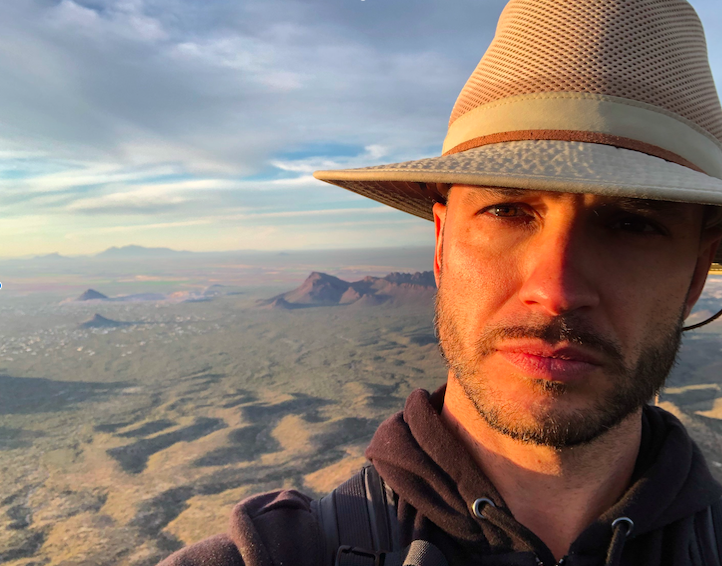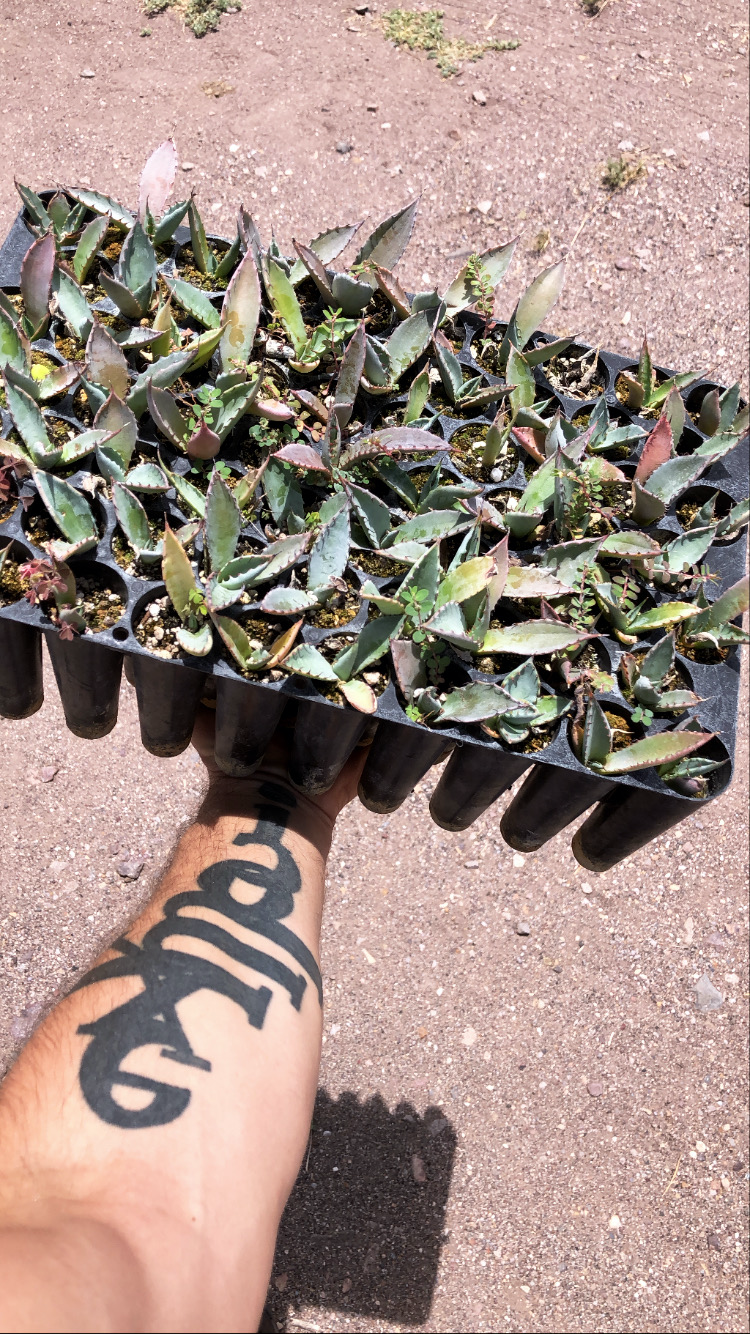SOWING SEEDS IN A SUMMER OF PLAGUE
SOWING SEEDS IN A SUMMER OF PLAGUE
August 2020
by Logan Phillips
The quail calls and coyote yelps wake me. The summer dawn comes so early, and with it, this chorus of wild sounds near and far, around my tent. Work won’t start for another three hours, so I roll over in my sleeping bag, pull a t-shirt over my eyes to block the sunlight, and drift back into sleep.
An hour or so later I unzip the flap and emerge into potting soil. When I arrived earlier this week, blasting winds raked the wide agricultural field on which the Borderlands Restoration Native Plant Nursery sits. It was impossible to set up a tent anywhere except right inside the potting shack, actually more of a ramada, but covered with a strong roof and oriented just right to block the gusts. I was grateful for the welcome and the hospitality of Francesca Claverie, Native Plant Program Manager, when she invited me to make my temporary home on the rich, black soil spilled little by little over years of repotting plants.
Right where you want to be, my mom says on the phone, over the chorus of yelps from my children playing in the background. Well, yes. What better bed for a lifelong lover of plants than to camp in this just-right mix of compost, perlite, cinder sand and coconut husk? What better place to rest after mornings spent propagating plants and afternoons spent wandering or writing––trying at all times to stay off of my phone, where the deluge of ever-worsening news threatens to sweep away the fragile headspace I’ve come here to find.
Last night in the dark I cleaned out an old coffee maker that had been gathering dust on a shelf, and I’m grateful for that now, as I pour myself a mug and walk out from under the metal roof of the potting shed. Just after seven and the sun is already strong, but any heat here is a relief compared to Tucson, where I live. The land that holds the Borderlands outfit is just outside of Patagonia, Arizona, a beautiful old railroad and mining town that sits in the floodplain between Sonoita creek and the Patagonia Mountains. Standing at 4,000’ elevation––2,000’ higher than Tucson––the temperature difference between the low Sonoran Desert and the Madrean foothills is significant. I breathe it in.
Beyond the potting shed / bedroom, there are six greenhouses of varying shapes, sizes and styles spread over the few acres. Because it’s early July, the plastic on most of the structures has been substituted for shade cloth, giving the young plants some protection from the desert sun. Plastic pots, pallets, brush piles––the general detritus of cultivation is piled all about, but it’s neither as messy as some operations I’ve seen, nor as showroom-esque as urban commercial nurseries. Standing here under the towering red Patagonia Mountains, these buildings huddled together give me the feeling of a Rebel base from the original Star Wars movies––especially once everyone arrives and gets to work. It’s a scrappy, young, hopeful place with an abiding feeling of faith in the work being done.
There’s Sarah, newly arrived from New Mexico to work as an intern, propagating native oak trees. Perin, the Borderlands seed whisperer, working the alchemy of air and water, a good witch. Travis, the technician and jack of all trades, building what needs to be built, a silent savant. Carlos, the 14 year-old dropped off by his dad once a week during summer vacation, who begrudgingly admits he likes volunteering here more than at the fire station, where they make him wash the engines. Lily, kind and tough, taking a pandemic pause from leading youth restoration crews in the field. Emmett, a generous hardworking guy, the only person I’ve ever met who regularly makes his own wine. Guiding our work is Francesca, gently and thoughtfully aligning our efforts towards the bigger picture, always in conversation with Perin, with each of us.
Given the plague conditions, we’re all wearing masks as we work together, but I imagine they smile often. At least I can still hear their laughter.
Maybe it’s that combination of faith and labor that keeps me interested in working with plants. It seems far-fetched that spending my morning sticking seeds of Agave palmeri into moist potting soil will do anything to fix the Sonoita Creek watershed. Such a huge spread of land, and my hands are so small. But I am a poet, so I have deep-rooted faith that minute, precise motions can have outsized affects over time. Words, arranged just so, create movements and bend society towards justice. Enough seeds rooting into earth will keep the topsoil from washing away, will create conditions for more germination, more flourish, more thriving, a virtuous cycle.
I don’t know what to do about this pandemic. Getting to a version of this country that doesn’t rely on white supremacy and exploitation feels impossible. Over these many months of quarantine, I’ve felt a helplessness creep in while staring into the bottomless pit of my phone. It can feel so far away, that world where everyone can find and create the poetry they need as a way of living. That world where poetry and plants––justice and health––aren’t luxuries for those who can afford books and the time to drive out of the city into the mountains.
I am small, my lifetime is brief. So how better to spend my time but moving my hands towards something too big to do alone. Towards healing, towards a whole. Palmeri seeds are paper thin and dark grey, I can hold hundreds at once, my hand a rolling landscape. Agaves clustered together on the ridgelines above the arroyos in my palm. A landscape to outlast me, plants in bloom long after my ashes have been given back to the desert.
Just today, an order came in for 500 agaves, to be used in a restoration project at nearby Fort Huachuca. Lily and Emmett walk over to the newest shade house to begin selecting from the nursery’s stock of two year-old plants, each grown from seed.
By mid-afternoon everyone has left the nursery. I’m again in the privilege and loneliness of solitude, lying in the hammock, the heat wavering up from the fields. Notebook on my lap, unopened.
The southern sky has started to darken. Above the farm the sky is still clear and the sun sharp, but already errant winds stray over the parched earth, troubling the dust, carrying possibility. I’ve just eaten and was drifting towards a siesta, but the almost-perceptible smell of rain and the booms of distant thunder send flashes of adrenaline through my tired body.
Unable to resist, I check the radar app on my phone. Looks like it’s already coming down just over the mountains in the San Rafael valley, on the international line. I can see that in the sky, but still I look to the phone to tell me what I already know. The first rain is coming in, quickly now––loose flaps of shade cloth whip in a cool gust, blue clouds run past the face of the sun.
My thumb opens the camera app. Towering bloom of agave, radiant in sunshine, the sky behind it a deep grape color, bulging with water. I send the photos to Francesca, who planted this agave years ago after rescuing it from a construction site. She replies immediately, also holding her phone in her hands. We all have our eyes to the sky, and reach towards one another the only way we can right now. Exclamation points, encouragement to take more photos as our work drinks deeply.
Thick drops goosebump my skin. Dust turns to mud under my bare feet. I hope this rain reaches to the next watershed, where my parents are. I hope my kids are dancing in it.
I won’t write any poems today, but today there is rain after months of none.
Logan Phillips is a bilingual poet and DJ. He is author of Sonoran Strange (West End Press / University of New Mexico Press, 2015) and has worked on a wide range of performance and education projects in the US, Mexico and beyond. Currently he is a MFA candidate at the University of Arizona in Tucson, where he lives with his family. More at Phillips’ website: www.dirtyverbs.com
[embed]http://vimeo.com/455100217[/embed]




